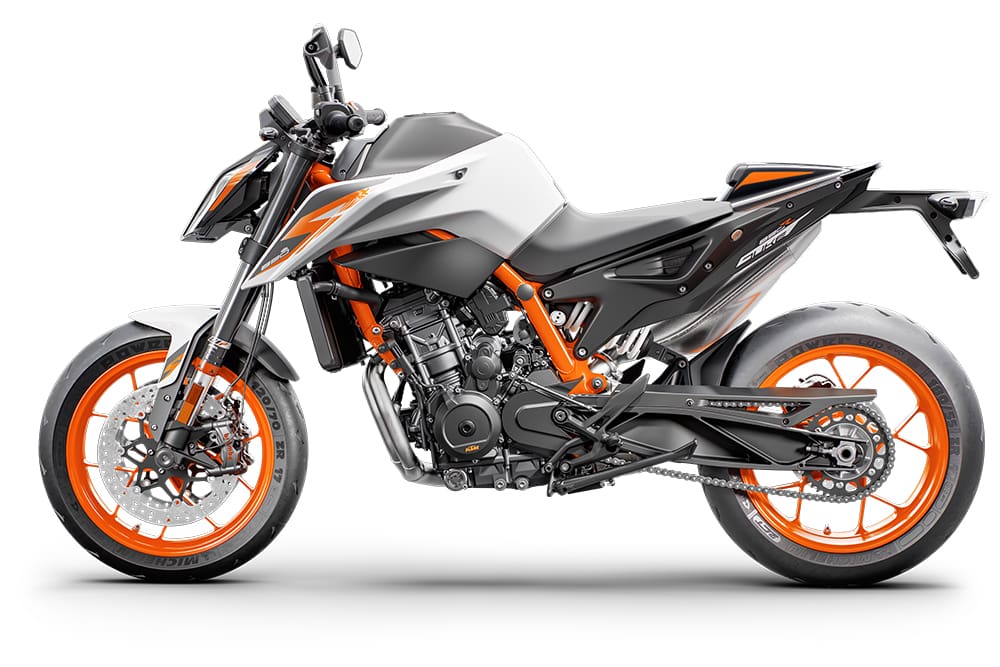KTM hit the reset button to re-develop the 890 Duke R and the result just may be the best model in the Austrian brand’s road bike range
Test Alan Cathcart Photography Heiko Mandl
KTM has had a smash hit with the 790 Duke, its first ever parallel-twin model launched two years ago powered by the LC8c (as in, liquid-cooled eight-valve compact) engine. Dubbed ‘the scalpel’ by many for its focused design and pared-to-the-minimum weight and bulk, it’s provided Europe’s largest manufacturer with a unique contender in the lucrative middleweight sector. And it’s been a top seller thanks to being competitively priced and fun to ride.
With its highly distinctive sharp-edged styling by Kiska Design, the 790 Duke has filled the pretty big gap between the single-cylinder 690 Duke and 1290 Super Duke V-twins in the Austrian firm’s roadbike range, and in doing so has brought an entirely new level of electronic sophistication to the mid-size sector, with features that some 1000cc Japanese Superbikes don’t even have.
Now KTM has gone one step further – actually, make that several steps – with the debut of the 890 Duke R at this year’s EICMA show in Milan. Lighter, more powerful and even more purposeful than its kid sister, this is clearly aimed at topping the middleweight sector in terms of outright performance and razor-edge handling, once again at an affordable price.
“We’re focusing here on the hardcore KTM naked rider, with a bike that’s developed for very aggressive street and track riding,” says Dutchman Adriaan Sinke, KTM’s Head of Product Management.
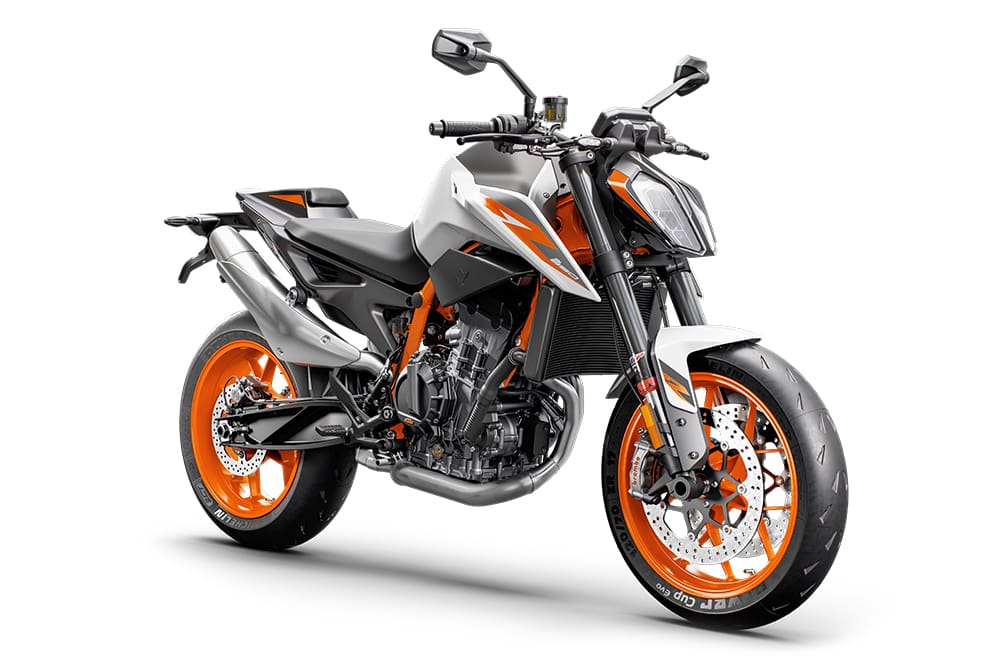
The 890 project dates back to 2012 when KTM engineers first began work on creating the LC8c parallel-twin motor. “We always intended to develop a 790 Duke R which was in our planning from the start,” states Sinke. “But then during the development programme, it got to the point that we weren’t happy with our prototype – it wasn’t enough R, not enough KTM. So we decided to produce just the 790 Duke to start with, and then go full attack on the R, and make it what we believe a KTM Duke R should be.
“So we basically tore up the spec sheet of the original, and went back to the drawing board to figure out how far we could take that engine and that chassis – and the 890 Duke R is the result.”
And what a result it is. By dint of increasing both bore and stroke of the LC8c motor to deliver a 90cc increase in displacement, KTM has achieved a significant increase in performance from the new engine, which delivers 99Nm of torque at 7750rpm, 13Nm more than the 790 Duke, itself until now the class-leading middleweight package, and 89kW at 9250 rpm, so 10 more kilowatts. Yet despite this, KTM has raised the revlimiter on this bigger-cubed motor by 500rpm to 10,500 revs, while at the same time reducing dry weight of the complete motorcycle by 3.3kg to 166kg, says Sinke – a savings mainly obtained by swapping to Brembo brakes from the J.Juans on the 790.
Because despite increasing the twin front discs diameter from 300mm on the 790 to 320mm on the 890, the new package is 1.18kg lighter all told, thanks mainly to using aluminium carriers for the discs, and Brembo’s new-gen Stylema radial one-piece calipers, which are both good-looking and also lighter than the J.Juan ones. Switchable Bosch 2-channel ABS is fitted as standard for Euro-4 compliance.
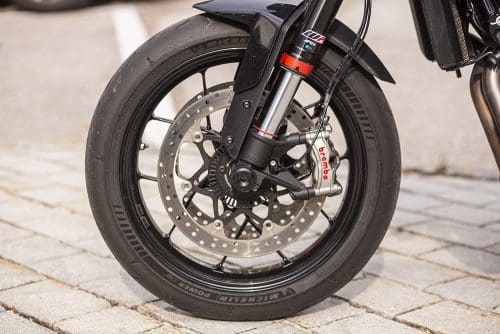
More power and torque yet with reduced weight (and largely unsprung at that, which has a beneficial effect on the now fully adjustable WP suspension – the 790 Duke’s was non-adjustable beyond rear spring preload) sounds like motorcycle R&D nirvana, and after being honoured to be chosen as the first person outside the company and its suppliers to ride the new bike in pre-production prototype form, it took about 10km out of the 180km I covered that day through the Salzkammergut mountains in KTM’s backyard, to realise how special this new machine really is.
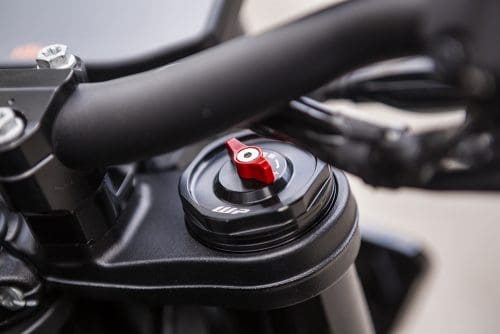
Another of the many apparent paradoxes on what is a remarkable new motorcycle by any standards is that KTM has achieved this weight-saving while actually increasing the rotational mass of the forged one-piece, three-bearing crankshaft by 20 percent, which of course makes it heavier overall.
This carries forged pistons via a sophisticated cracked conrod design, which results in low piston weight and reduced reciprocating mass. The crankpins are offset by 75º (versus the more common 180º or 270º crank throws) with 435º firing intervals to replicate the gritty sound of a KTM V-twin’s irregular firing order. That heavier crank is to deliver a sense of momentum as the engine spins up, says Sinke, as well as greater stability in turns thanks to the gyroscopic function of the engine.
That then necessitated redesigning the twin counterbalancers – one at the front of the engine and one in the cylinder head, between the camshafts. Compression ratio has been raised from 12.7:1 to 13.5:1, thanks to a knock sensor now added to obviate detonation, and this in turn helps deliver improved acceleration. There are 1mm bigger valves all ’round, with the 790’s paired 36mm inlets increased to 37mm, and the 29mm exhausts to 30mm, operated via all-new camshafts with higher lift and more aggressive timing.
Those cams are chain-driven up the right of the cylinders, while the optional Quickshifter+ powershifter on my test bike allowed clutchless shifting both up and down the unchanged ratios of the six-speed gearbox, matched to a slipper clutch which is cable-operated for ease of maintenance, and to save weight.
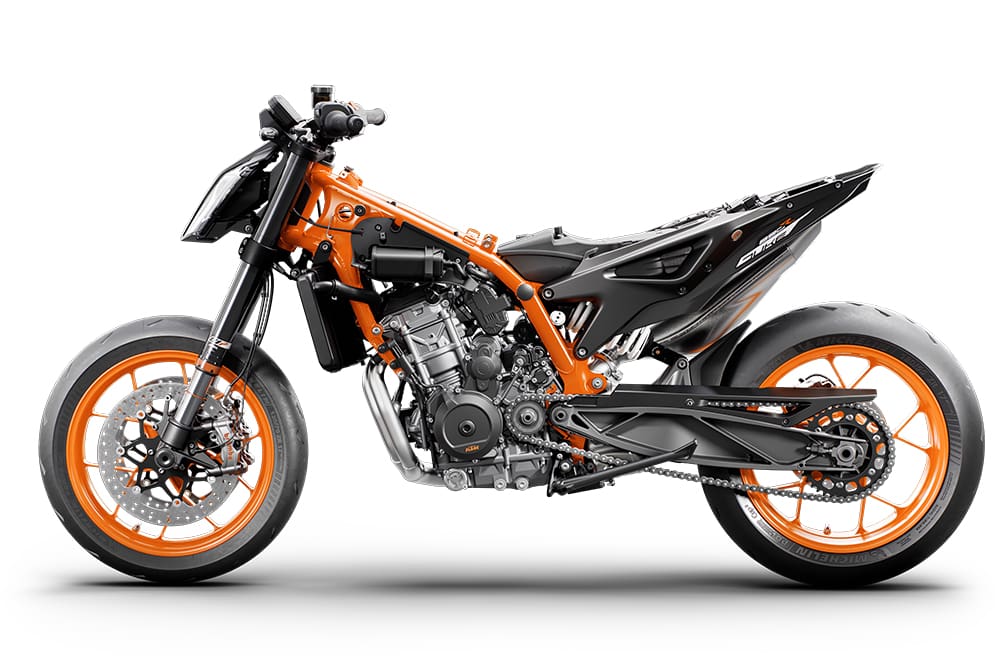
As on the 790, the Nikasil-lined cylinders are integrated into the upper half of the high-pressure diecast aluminium crankcases. KTM has also shortened the engine considerably by stacking the gearbox shafts vertically one atop another, and they’re surmounted by the shifter mechanism right beneath the unchanged 46mm Dell’Orto throttle bodies, which are fed cool air from an airbox under the seat. And in what Sinke says is a significant step in optimising performance, each of the two cylinders is now mapped separately one from the other, delivering a more refined power delivery.
The result is a package that’s more intuitive to ride than the already super-friendly yet fast 790 Duke. The engine is even more of a gem than its forebear, pulling hard and strong from just 2000rpm on part-throttle, or wide open in sixth gear from 4000 revs. Because power keeps building all through the rev range, you do have an inducement to flirt with that 500rpm higher revlimiter, but if you do hit it there’s a soft-action cutout thanks to the RBW digital throttle. Yet the harder you rev it, the paradoxically smoother the engine becomes – those counterbalancers really do their job, and it’s a smooth operator at all times as it carves corners through the Austrian countryside. But thanks to that extra dose of torque, it’s happy to be short-shifted to let you ride the torque curve through a series of bends interspersed with short straights, and here the optional multidirectional powershifter really worked well, letting you zap clutchlessly up and down the gearbox’s well-chosen ratios.

Just as the 790 Duke, the new 890 R feels small, slim, short and sporty, with a close-coupled riding stance that has your chin seemingly over the front wheel. It’s a responsive, eager-revving bike that’s not only thoroughly practical but also hugely entertaining, and totally straightforward to ride as hard as you like on. It’s one of those bikes where you feel a part of it from the very moment you hop aboard.
Yet at 11,990 Euro in Germany (Aussie price is yet to be announced), the 890 Duke R is a lot of bike for the money – okay, it’s at the upper end of the middleweight category, but it’s well priced against the 1000cc bikes it competes with on performance.
“We think this bike is for an intelligent rider who doesn’t have the biggest ego, who realises that power to weight is more important than throwing down 180 horsepower on the bar at night,” says Adriaan Sinke. “This is someone who’s a very enthusiastic motorcycle rider, who really understands where the gains can be made. For this reason I’m convinced that the 1290 Super Duke is not at risk because of the 890 R, so we won’t be selling against ourselves.
“They’re different beasts – one is a 180hp monster, and the other is a 120hp super scalpel – we call it the evil twin!”
Evil is as evil does, and the key to the 890 Duke R’s significant dose of extra performance isn’t just the various engine mods KTM has concocted to stay ahead of its rivals, but its lighter weight which besides improving acceleration, also makes the bike so much fun to ride hard on in twisty stretches of road. The KTM switches direction almost on autopilot – its handling is so precise and intuitive, it seems you need only think about making a turn, and the 890 Duke R has gone and done it for you.
The overall ride height has been increased by 15mm, and this improves the anti-squat behaviour, because the swingarm is more in line with the drive-chain, so the bike doesn’t squat down as much as before at the rear under hard acceleration. It also means the riding position has been subtly altered so you’re now sitting 15mm higher at 834mm, and thanks to the new, flatter handlebar you’re leaning further forward in what is a sportier riding position than on the 790.
This isn’t any more tiring than before, just more sporty – you feel even more involved with the bike physically, and that’s one reason for the intuitive riding style I mentioned earlier. And even at speeds of 200km/h with the tacho showing 7500rpm, you don’t get too blown about thanks to the slightly more aerodynamic stance.
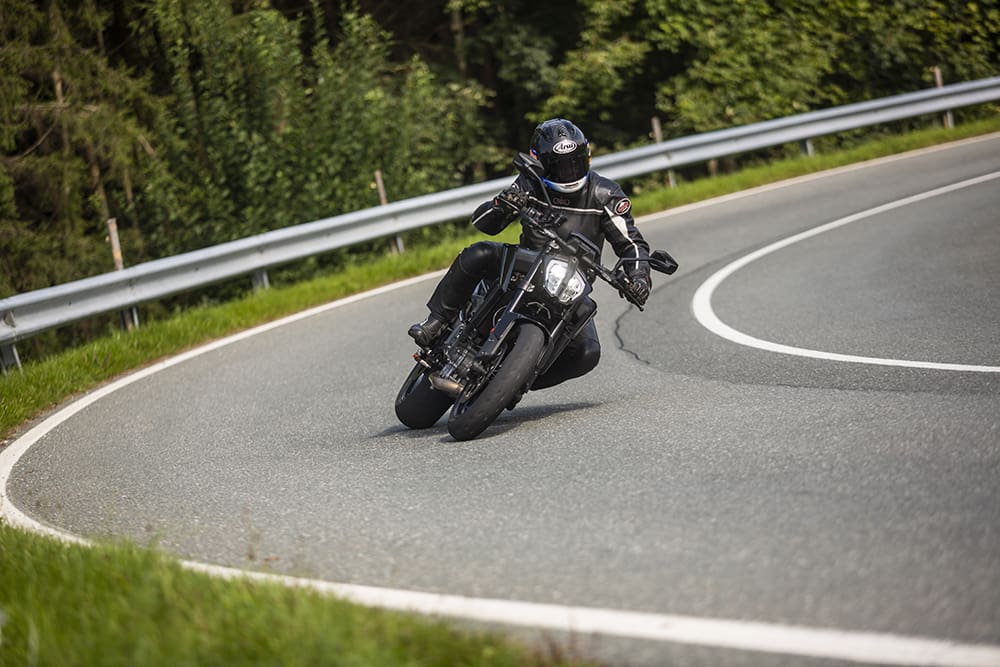
I started out using Street mode out of the four available via the RBW digital throttle, before switching to the sharper but still controllable Sport map – there’s also a Rain mode capped at 100hp with a smoother pickup, and an optional Track mode for track days, with launch control, MTC slip adjust, revised mapping and throttle response, and the anti-wheelie turned off. But I ended up using Street for most of the day, as it’s better for real-world road riding in traffic and on tight, twisting mountain roads, switching to Sport when the road opened up so I could be more aggressive on the throttle. It really pays to surf that flat but meaty torque curve, so short-shifting wide-open at 7500 rpm gave me plenty of acceleration en route to 160km/h in top gear with 5800rpm showing on the good-looking light-sensitive full-colour TFT dash. And as on its low-cost 125/200/390 Dukes, KTM’s dashboards are a model of readability to others.
That compact engine format and the sharper sense of purpose you get riding this bike compared to the 790 makes it feel like a single in the way it steers, but like a maxi-twin in terms of power and torque. The 890 Duke R comes close to being the best of both worlds dynamically: it’s light and agile, responsive to rider input – but with added power and torque compared to the smaller capacity version of the same model. And those magnificent brakes which deliver so much feel and bite without being snatchy, are just the icing on the cake.
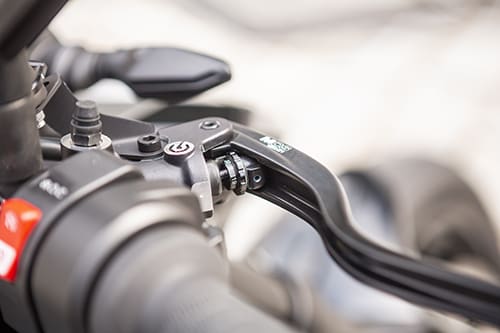
The only place that hard-riding Adriaan Sinke pulled a gap on me with his 1290 Super Duke R was up a long, quite steep 2km-long climb where the bigger V-twin’s extra cubes and added punch won out. Elsewhere, the more agile, more nimble 890 Duke R was the bike to be on, especially once we got to tight mountain turns where the sweet-steering twin that thinks it’s a single won out every time in handling terms.
The 890’s appeal is mainly about power-to-weight ratio, and its more agile handling compared to a physically bigger V-twin – not just KTM, but any other manufacturer. It encourages you to brake later and accelerate harder after flicking the smaller-seeming bike through a turn. You’re aided in doing that by the new Michelin Power Cup II tyres fitted to the bike, which according to Sinke are much lighter than any comparable previous tyre from the French manufacturer, so benefit handling via reduced unsprung weight.
The reduced unsprung weight obtained by those lighter tyres and especially the Brembo brakes allows the fully-adjustable WP suspension specially developed for the 890 Duke R to deliver optimum compliance in riding as aggressively as you like. The new KTM also rode the copious bumps on degraded frost-ravaged tarmac up in the Salzkammergut mountains really well – ride quality overall is excellent.
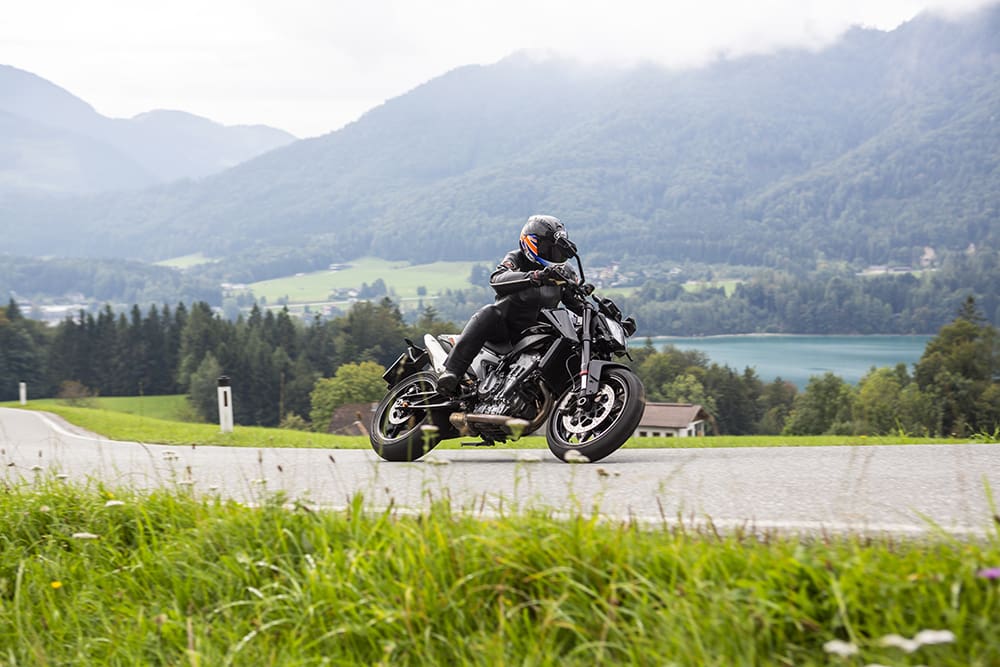
The 890 Duke R’s steering geometry is quite aggressive, with 24.3º of rake and 98mm of trail, delivering a 1482mm wheelbase. But its agile, super-responsive handling is the payoff for that, coupled with total stability on fast third or fourth-gear turns – it feels planted to the tarmac, yet the great leverage from the wide, taper-section aluminium handlebar lets you carve corners and especially switch direction from side to side really easily. That handlebar can be adjusted almost infinitely in search of your preferred riding position – in addition to four different clamping positions offered by the upper tripleclamp’s design, you can also rotate the ’bar through three different angles to get comfortable with it. Thanks to the narrow seat where it meets the fuel tank at 180cm I could also put both feet flat on the ground at rest, in turn adding to the sense of being at one with the bike.

KTM’s engineers have done it again – they’ve successfully tackled the hardest task in two-wheeled development, and made the best better still by improving on what was already a market-leading motorcycle. They’ve produced a machine that’s a significant step up from the basic model in what is already a stellar platform.
No less an authority than Jeremy McWilliams, who’s been one of the test riders involved with the project from the start, and was responsible for the final mapping of the Keihin electronics, concurs. We were racing against each other at the Goodwood Revival a couple of weeks before I flew to Austria to ride the 890 Duke R.
“You’ve got a treat in store,” said Jezza as we sat together waiting for riders’ briefing to start.
“It’s nearly everything you could look for in a real world roadbike – it’s light, slim and fast, plus it feels very refined. We put a lot of time into getting the engine characteristics just right, and I’ll be surprised if you don’t like it, because in my opinion it gives the 1290 Super Duke R a serious run for its money as the best bike in the KTM range and a candidate for being the best real-world performance bike money can buy. Have fun!”
You know what? He’s right – and I did!

